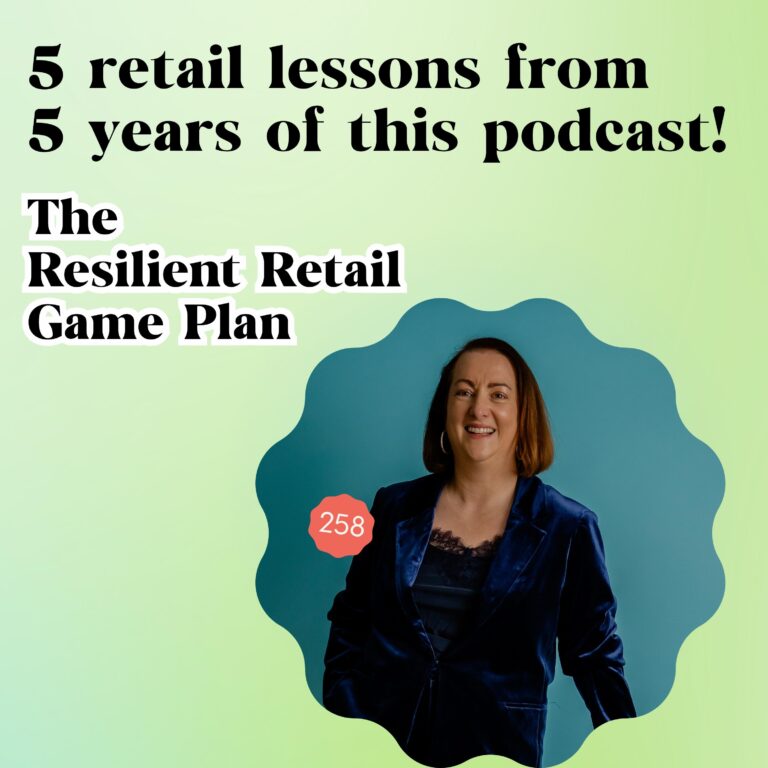How do I clear slow stock without damaging my brand?
Catherine Erdly: A few weeks ago, I ran a talk on stock management and as part of the preparation for the talk, I asked nearly 100 people who were signed up to attend what it is that they most wanted to hear about in the talk. And the number one response that came back was the theme of today’s episode, which is how do I clear slow stock without damaging my brand.
And actually on Instagram recently, I asked people about what they’d be most interested in hearing about with a poll. And again, the number one winning topic is this one, how to clear stock without damaging your brand. So without further ado, let’s dive in.
Hi, I’m Catherine Erdly. I’m the founder of the Resilient Retail Club, which is my membership group and mastermind for product businesses.
You are listening to the Resilient Retail Game Plan. This is episode number 211, and we’re going to delve deep into the world of clearing stock.
Welcome to the Resilient Retail Game Plan, a podcast for anyone wanting to start, grow or scale a profitable creative product business with me, Catherine Erdly The Resilient Retail Game Plan is a podcast dedicated to one thing, breaking down the concepts and tools that I’ve gathered from 20 years in the retail industry and showing you how you can use them in your business.
This is the real nuts and bolts of running a successful product business, broken down in an easy, accessible way. This is not a podcast about learning how to make your business look good. It’s the tools and techniques that will make you and your business feel good.
Confidently plan, launch and manage your products and feel in control of your sales numbers and cashflow to help you build a resilient retail business.
Understanding Brand-Damaging Strategies
Catherine Erdly: So what I’d like to address, first of all, is what actually is a brand damaging strategy when it comes to stock clearance and what is the risk here? So why is it risky?
What, what, what’s going on? So the, the people that I always point to when I come to talk about this subject is. The GAP In fact, it’s called the gap trap, which is where you just run so many discounts all the time that the customer is 100 percent trained to wait for a discount and to not even bother buying from you at full price.
Discounting. I worked for a CEO who used to call it the discount drug. And he was saying, you know, once your customer gets hooked on it, it’s almost impossible to win them off it. So he was very adamant that we were very careful with the discounting strategy. And when we’re talking about, so when we’re talking about things that are brand damaging, what we’re really talking about these blanket discounts, everything, 25 percent off everything, 40 percent off everything, or just really like extensive 40 percent offs like.
Gap, almost anything that you would pick up in store would be 40 percent off. You could almost guarantee it.
Principles of Effective Discounting
Catherine Erdly: So let’s think about a few principles then when it comes to discounting. First off is what I like to say, which is that discount looks like it’s for your customer, but it’s actually for you. The discount is you doing something to your prices that really encourages certain behaviors that you want from the customer, such as clearing through some stock or purchasing stock that maybe they hadn’t been purchasing previously, because you want to clear through it.
And another general principle to think about with discounts is this. Life is easiest and most profitable for any business when the customer believes that they have to pay full price for something otherwise, they risk not getting it.
So I’ll say that again. So. For any business, any retail business, the most profitable approach is for your customer to believe that if they want something, they’ve got to buy it from you at full price. Otherwise they can’t guarantee that they will get it.
So for example, gap is the opposite of that. Nobody ever saw something in gap and worried that they should buy it there. And then otherwise they might not get it. They always knew that there was going to be a promotion coming along. There was no sort of exclusivity, excitement, people thinking I must get this. Otherwise I am absolutely not going to have this thing that I love.
So these blanket discounts, they really undermine this customer belief. The customer is just, I’m going to know that they just got to wait for the right discount to come along and that’s it, they’re sorted. So when we’re thinking about clearing our stock without damaging our brand, we really want to be avoiding this idea that don’t worry, wait a couple of weeks.
And therefore I’m going to be able to get this at a discount. You really want to be playing into this idea that, that yeah, I’m doing some discounting off a few things. But if you want this item, then you’ve got to get it. So that’s why targeted discounts and sales are not as damaging to your brand as a blanket promotion, because the customer doesn’t really know what you’re planning.
They don’t know what’s going to be going on. And so if they really want something, they’re going to have to buy it at full price. So imagine that you have your eye on a beautiful bag and the business. That you follow the brand that you follow that has this lovely bag. Occasionally they offer money off selected jewelry, but you can tell that when it comes through, it’s usually just a few items of jewelry that got a discount, or maybe they’ll do like a money off scarves from time to time.
But you don’t really know if they’re ever going to do that for bags. So, you know, maybe you keep waiting. Maybe you keep waiting and hoping that they do a deal on bags, but you don’t know, even if they do do a deal on bags, are they going to include the one that you want? Or maybe you can tell that this is a new line and they only ever seem to do discounts off older stock.
So generally speaking, if you want that bag, you may not be sitting around waiting. You’re much more likely to buy at full price. Whereas if the business regularly runs 20 percent off everything or 25 percent off everything, and they do it like once a month or even every couple of weeks or anything like that, then you probably will wait.
You’ll be like, okay, I like that bag, but they’re always doing deals. So I’m just going to wait and see if that deal comes along. If they, they do that 20 percent off. Cause I know they will. Cause they always do. So. You can see there that using the targeted discounts, which are really great for you as a retailer, because it means you can get into the product that isn’t working, that isn’t selling and, and offer the customer money off.
So they’ll actually trade into that and buy that instead. You can see how that wasn’t as damaging to the thought process of the customer as doing those regular money off everything blanket discounts. So if you’re really keen to not damage your brand, Then avoid the blanket discounts, but think more about the targeted discounts.
So how do you work out what you’re, what you should do, what you should offer?
Identifying and Categorizing Your Stock
Catherine Erdly: Well, the way that I like to think about it is that not all stock is created equal. So some stock is really desirable. You don’t ever want to touch. And some stock is the stuff that you need to tackle. So. When you are looking to clear your stock, then you want to start thinking about looking at splitting it up into different buckets.
So the five buckets of stock that I suggest that you divide your products into are as follows. The first one is your prime stock. So your prime stock are your best sellers. Now, if you use Shopify for your business, and your stock records are up to date, which I’m very much hoping they are.
Go to the ABC report because this report is brilliant. I would even go as far as saying you could look at this report every week because it’s very interesting and it gives you a lot of really good information about what’s working and what’s not working in your business.
So your prime stock is what they would call your A stock. It’s the stock that is generating 80 percent of your sales. Now, if you’re not Shopify user, you can work this out as well. You will want to say run your last month or your last three months worth of sales. Rank it from your best to your worst, and then work out what 80 percent of those sales represents, and then work out which products are generating those 80 percent of sales.
That is your prime stock. This stock, you don’t really want to touch. You are going to sell it anyway, so you really don’t want to be offering it to your customer at a discount. So that is your prime stock. You’re just going to leave that be.
You then have your okay stock. This again would be your B stock in Shopify. Your okay stock is, it’s not in your top 80. It’s not generating that top 80 percent of sales. It’s okay. But to be honest, You know you’ll sell through it eventually, so you don’t really have to take any action against it. You don’t want to rebuy it. Now you, if you run out of your prime stock and it’s something that you want to carry forward, then yes, absolutely rebuy that.
If it’s your okay stock, if it’s just sort of okay, but you don’t have to necessarily take action against it. It’ll tick over in its own time. You’ll feel fairly confident you’ll sell it. But equally, so you don’t have to reorder it. In fact, I would strongly suggest you don’t reorder anything other than your prime stock. So that is your second bucket.
The third bucket is now this stuff could maybe not be selling or some of it might be selling. So this is your ends of line or your single items. Now, this may not apply to you if you’re somebody who sells one offs. So in that case, you may not have this bucket, but if you’re somebody who sells different types of products, or maybe you sell it in collections, and then they always end up with a sort of fragmented pieces of stock at the end, or maybe it’s something that was a bestseller, but now you’re just down to the last one or two, and people aren’t responding to it as much.
Now these ends of lines, it’s useful to identify these. Sometimes you don’t even have to do a discount on these. Sometimes it’s enough to send an email out to people saying last chance to buy, or doing something on stories where you’re telling people that you’ve only got one left of something.
And the reason for that is if you ever go into a shop, then for example, I worked in clothing for many, many years and the most heavily shopped rail was the last chance to buy rail because people really liked the idea of getting something that was, the last chance, you know, like the one off the single that somebody, you know, had been super popular and there’s just one or two left.
If they’re damaged, if they’re shop soils or just whatever reason, the second, then you could keep them and do them, in to a samples and seconds sale. That could be something. Those also are not brand damaging because people get what those are. They’re you giving them something at a discount because it, you know, as a smudge on it or something like that. So that can be what you can do with your ends of line.
Strategies for Clearing Slow Sellers
Catherine Erdly: Then you’ve got your slow sellers. So these are the products that you. Maybe bought because you thought they were going to sell well, maybe they were previous bestsellers, but they’ve really slowed down. But whatever the reason, these are the ones that you want to tackle with your discounts.
Another question I get asked is how quickly can you tell whether something hasn’t worked? Great question. Fast fashion, Sometimes it would be pushing like the 28 day legal requirements. So there’s a legal requirement to price establish something at 28 days before you can discount it and say it was now.
So it’s to stop people bringing something in on a Monday for 10 pounds. And on Tuesday saying it was 10 pounds is now five pounds. It has to price established for 28 days at that 10 pounds to be able to legally use that phrase was now. So some fast fashions, we, we would have to push back. Sometimes when I worked for clothing retailers, we had some of our products with fast fashion brands, and they would ask us like, how long has this been price establishing?
So they could decide whether or not they were going to discount it. So they would discount something within four weeks. Most small businesses are not working at that speed. So I would say, you know, slow sellers often are apparent quite quickly though, things tend to be. desired by people or not.
if you have something that is a slow seller, I would definitely try re photographing, re promoting it. If it’s in store, re merchandising it somewhere else, try giving it a new lease of life. And if that doesn’t work, then maybe I would say within about two months, you could definitely say something was a slow seller for sure.
And possibly even sooner, but for most small businesses, you’re not going to be trying to discount something until you’ve had it for probably at least, um, Minimum, minimum two months, but probably more like three to six months.
And then you’re going to have your out of season stock.
If you were looking at the Shopify report again, then ends of line, slow sellers and out of season might all end up in that C bucket. So I would just in the ABC report. So I would just be clear on what is what, because again, if something’s out of season, let’s say it’s Halloween earrings and it’s currently July.
You don’t definitely don’t want to be discounting that sort of stuff. Because it’s just, it’s just not its time of year. And if you’re planning on bringing that back out later on, then you don’t have to take any action against it now. Now you do in general want to try and minimize the amount of out of season stock you’re carrying at any one time, but that’s something for you to deal with at the season in which you’re buying it and planning it rather than trying to address that in between.
So. Make sure you’ve got those five buckets, the prime stock, your okay stock, your ends of line, slow sellers, and your out of season. And then once you’ve worked out what is what, basically you put together an offer to tackle your slow sellers. So that might be, let’s say you do all of this and you work out that you’ve got this whole range of lovely silk scarves that you thought were beautiful, but for some reason the customer’s never gone for.
So that might be then something one time you do a special price for email subscribers on These silk scarves, or you do a live where every, every scarf is 10 pounds for that day, only down from 15 or something like that. So that’s the kind of thing that you build into then your marketing calendar, your promotional calendar to start thinking about how you can use that as a message.
And again, it’s, that to me is not brand damaging. If you were doing it all the time on half of your stock, then yes, that do becomes more brand damaging. But when you’re making it super targeted, then it’s almost like an interesting message or a special price that week for that item. It’s much less about that mentality of, Oh, well, if I wait long enough, something will get discounted because actually what most people, statistically speaking, what most people will be looking for will be your best sellers, which you’re never going to discount very rarely.
So that is, that is it in a nutshell. Look at what everything is and only target the slow sellers do that in a very targeted way. Or alternatively, if you really do not want to be running any promotional messages at any point and you, that still makes you nervous, then save it all up.
Identify it as things for your end of season sale. And twice a year, you really go big on your sale. So go deep on your discounts. That would be my top tip for running a sale is you want to get rid of this stock. So if it needs to be 50 percent off, it needs to be 50 percent off where I see a lot of people going wrong is they’ll have a sale, but then they’ll do maybe 20 percent off, which is not always enough of a discount to get people’s attention.
So go for it with a heavier discount for a stock clearance sale. And just make sure that you are really enthusiastic. And you really promote the sale and with the same amount of enthusiasm as you would a new product offering because you know, everyone has sales.
Selfridges has sales, Harrods has sales, Liberty has sales. This is not something that is distressed. This is not something that is brand damaging. This is something that is about giving your customers chance to get great products at great prices. So make sure you shout about it across all your channels.
One of the reasons I think people’s sales don’t always work as well as they Would like number one, they often aren’t discounting heavily enough. And number two, they’re not shouting about it enough. So make sure you’ve got a plan to really talk about your sale with as much enthusiasm as a new product launch.
Now you may be listening to this thinking, okay, I’ve tried the sale. I’ve tried this. I’ve tried that, but I’ve still got stock left. So if you’re in this boat and you still have a large amount of stock, then I do have a few other suggestions for you.
Secondary Methods for Stock Clearance
Catherine Erdly: You can think about a secondary method. So by that, I mean, something that is not connected to your main store.
So that could be an eBay shop, or it could be going to a market and selling, or particularly if there’s an event where people are more budget conscious and you’re basically just selling things off whatever price you can get for it. You know, everything a pound, whatever it might be. If you’ve got too much stock, it takes up physical space.
It takes up mental space and it’s taking out space in your bank account or leaving a hole in your bank account. So it may sound really brutal to talk about slashing things to really low prices and getting rid of it. But to be honest, if it’s not selling and it’s just dragging you down and you’re having to rearrange things around it, then You might want to just take it somewhere that’s not connected to your main business and just try and get whatever you can for it.
You can also talk to your accountant about doing donations of stock as a tax break, and they’ll let you know if that’s going to be a possibility for you and what you need to do. But basically the idea is you’re just trying to get what you can for it. So my first port of call would always be a targeted discount.
They can feel quite premium. You know, as I said, Liberty do this whole thing all the time, you know, get, spend more, save more on us. Special spring offers, whatever else it might be. I would say targeted discount first off, alongside a clearance sale. And if those don’t work, you still got too much stock.
Then I say secondary method of clearing it that’s unrelated to your business. So your own customer doesn’t necessarily realize it’s you doing it. Lots of big retailers do this. They often have eBay accounts, which you wouldn’t necessarily know run by them. And they use it as a way of just clearing some stuff that they have tried other methods of clearing and been unsuccessful.
So, just give it a go, but keep it really targeted. Make sure you do not touch that prime stock. That is the stuff that you’re going to sell anyway. So if you sell it at a discount, then you are really damaging your profitability. But if you’re not going to sell it at the price it’s currently at, then it needs to get reduced. We always used to say everything has a price. You just have to find it.
So sometimes you might even start at 50 percent off and that doesn’t shift it. And so you go deeper. The key thing here is to really look at your stock in break it down in these different buckets and to make sure that you’re offering these promotions in a way that’s enticing to the customer, that you’re shouting about them.
And that doesn’t lead your customer to believe that. Don’t worry. At any point I can get anything I want from this brand at a discount. They’ve got to understand. These are limited time offers only on certain items, and that will avoid you damaging your brand.
Additional Resources
Catherine Erdly: If you want to know more on this subject, I’m actually giving away a free chapter of my book, Tame Your Tiger, which is all about stock clearance.
And so if you want to get it, then head on over to the show notes for this episode, and you can download it in there. And I’d love to know why not come over to Instagram at resilient retail club and let me know how you are going to be tackling your stock.







